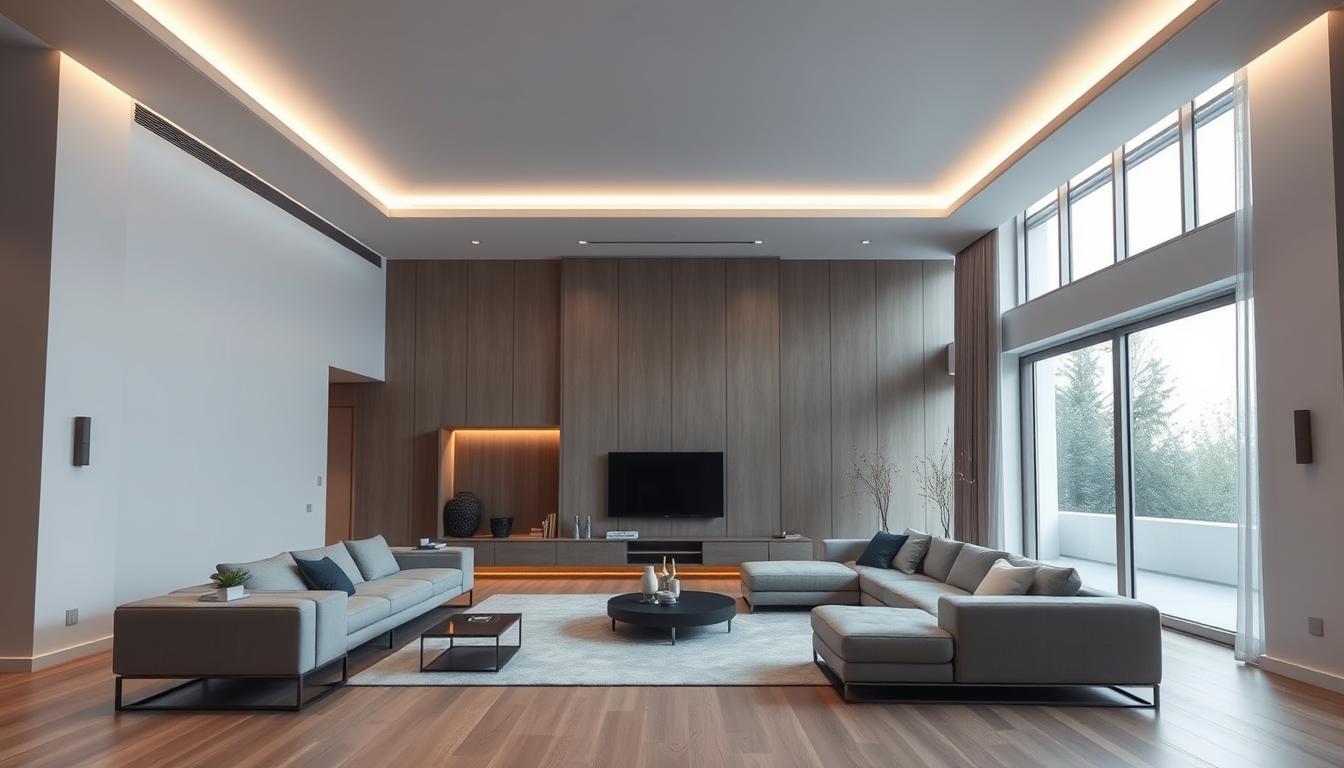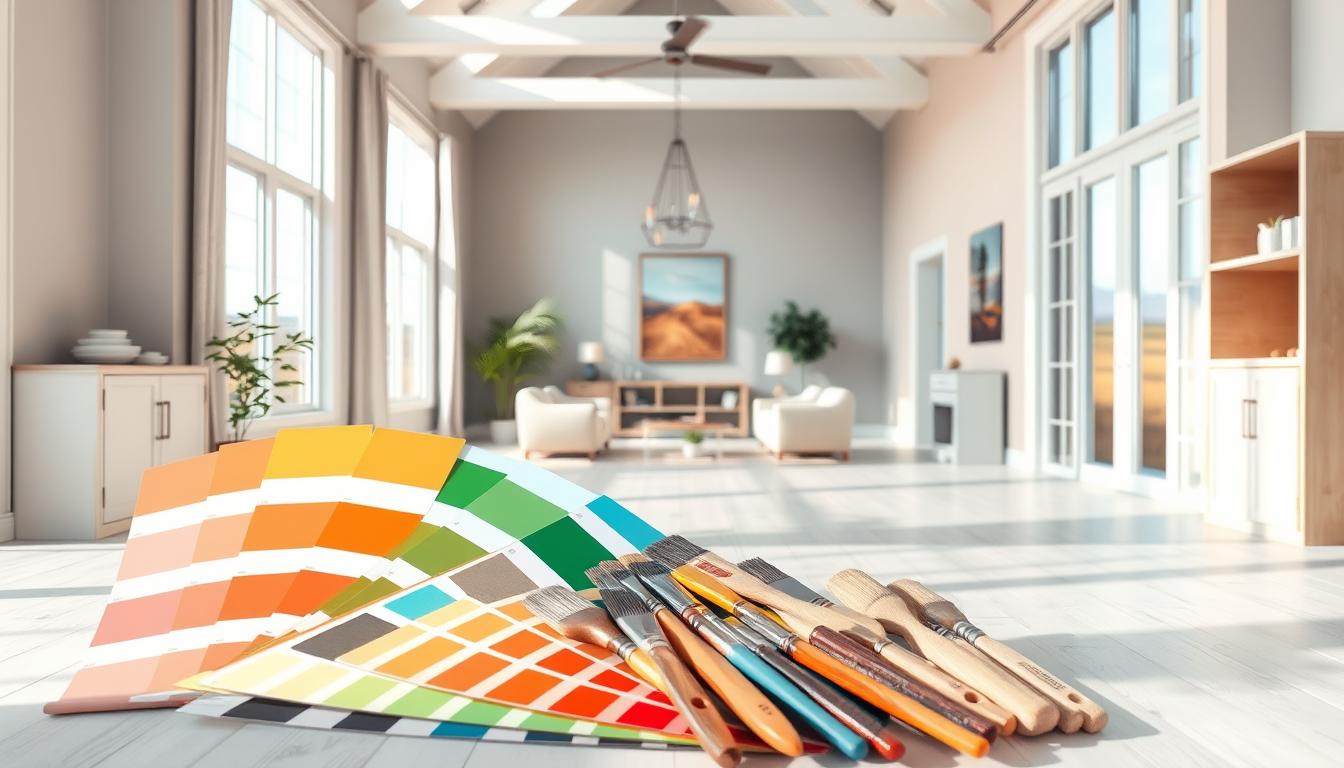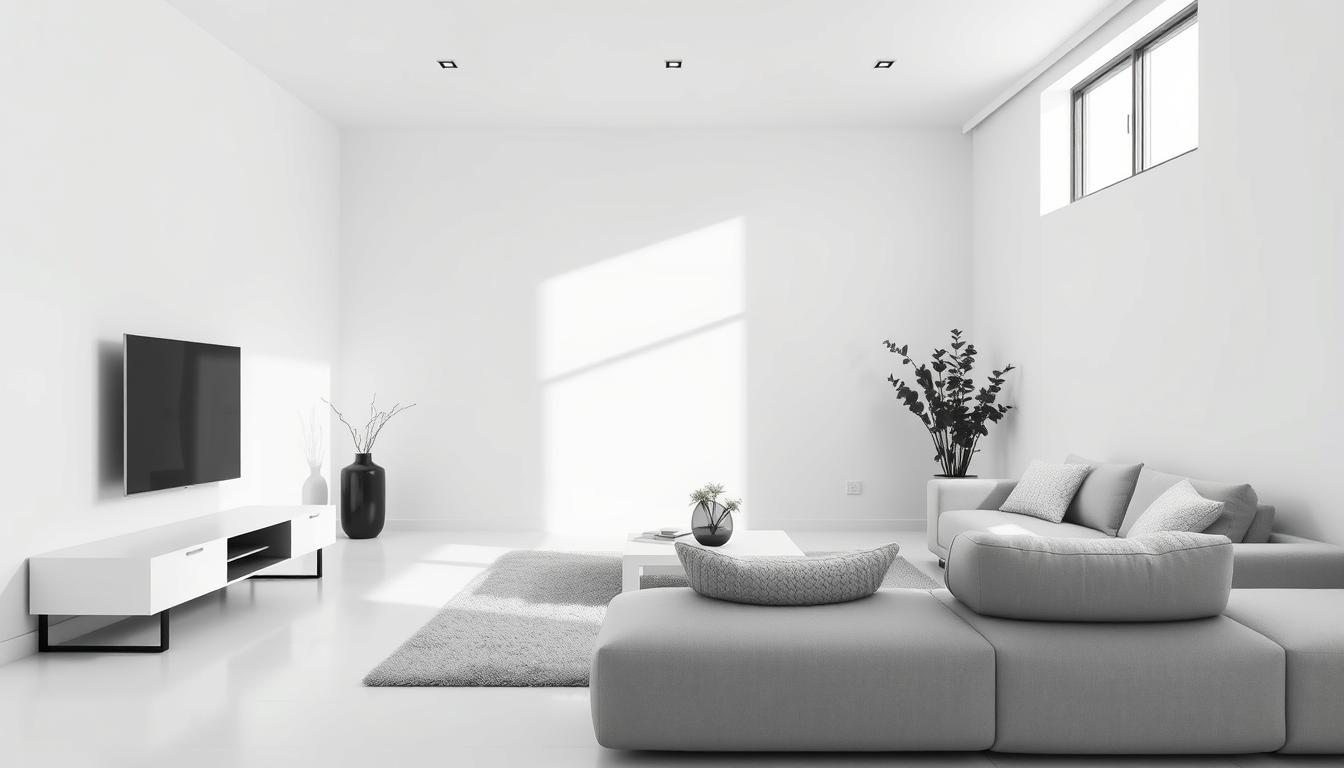Did you know the global smart home market is set to hit $146.3 billion by 2027? This shows how much people want to make their homes tech-savvy. Smart home interior design blends style with cutting-edge tech for homes that are both stunning and smart.
We’re in a new era where interior design goes beyond picking furniture and colors. It’s about adding smart home decor to improve our lives. This guide will cover smart home design, from new tech to design tips for a smart home.
Key Takeaways
- Understanding the basics of smart home interior design
- Exploring the latest technologies in smart home decor
- Design principles for creating a smart home
- Benefits of integrating technology into your living space
- Tips for implementing smart home interior design in your home
Understanding Smart Home Interior Design Concepts
As we move forward, smart home interior design is key. Our homes are changing due to new tech and lifestyle shifts.
What Does Smart Home Mean?
A smart home uses advanced tech to make life better, easier, and more efficient. It adapts to your needs, making your home more enjoyable. It includes many technologies and devices that work well together.
The term “smart home” means using tech, automation, and connectivity in your home. This includes lights, temperature, security, and entertainment, all controlled remotely or automatically.
The Role of Technology in Interior Design
Technology is crucial in modern interior design. It changes how we design and use our spaces. It’s not just about looks; it’s about function, efficiency, and meeting our needs.
Interior design trends now focus on tech, like smart devices and systems. This includes smart lighting and thermostats that learn your preferences. Tech is changing how we live in our homes.
Adding tech to home design also means more customization and personalization. With smart home tech, you can make your home fit your exact needs and tastes. This makes your home more comfortable and fun.
Key Features of Smart Home Interior Design
Technology and design are merging in our homes, thanks to smart home interior design. These features make our homes look great and save energy. They also help us live more sustainably.
Integrated Smart Devices
Smart devices are the heart of smart home design. They include smart thermostats and lights that work together for a smooth living experience. For example, smart lighting changes color and brightness based on the day and light outside. This makes our homes more comfortable and saves energy.
One of the best things about these devices is how easy they are to control. We can use our phones or voice assistants to manage them. This gives us a lot of flexibility and convenience.
| Device Type | Functionality | Benefits |
|---|---|---|
| Smart Thermostats | Temperature Control | Energy Efficiency, Comfort |
| Smart Lighting | Lighting Control | Ambiance, Energy Savings |
| Smart Security Systems | Home Security | Enhanced Safety, Peace of Mind |
Energy Efficiency and Sustainability
Smart home design focuses on saving energy and being green. Modern home automation helps us use less power. For instance, smart thermostats learn our habits to save on heating and cooling. This cuts down on waste and lowers our bills.
“The future of interior design is not just about aesthetics; it’s about creating spaces that are sustainable and efficient.”
As we look to the future, green design will become even more important. This is thanks to new tech and our growing concern for the planet.
Benefits of Smart Home Interior Design
Smart home interior design brings many benefits, like better comfort and security. By adding smart tech to our homes, we see big changes in how we live.
Comfort and Convenience
Smart home design makes life easier and more comfortable. You can control things like lights, temperature, and entertainment with just a voice command or a tap on your phone. This makes your home more convenient and enjoyable.
- Control lighting and temperature with smart thermostats and lighting systems.
- Enjoy seamless entertainment with smart speakers and assistants.
- Enhance your home’s ambiance with automated window treatments.
These features make daily life simpler and more fun. For example, smart lighting can wake you up like a sunrise, making mornings easier.
Improved Home Security
Connected home design also boosts home security. With smart devices, you can watch your home live, get alerts for security issues, and even scare off intruders.
- Smart door locks and cameras provide enhanced surveillance.
- Motion sensors detect unusual activity and alert homeowners.
- Smart alarms can be integrated with local law enforcement for added security.
Smart security features give homeowners peace of mind. As we keep using smart technology in homes, we’ll see even more ways to make our lives better.
Essential Smart Home Devices for Interior Design
The heart of a smart home is its devices. They make our lives easier and more comfortable. In interior design, some smart gadgets are key. They improve both function and look of our homes.
Smart Speakers and Assistants
Smart speakers and assistants, like Amazon Echo and Google Home, control other smart devices. They let us change lighting, temperature, and entertainment with just our voice. This makes controlling our home easy without touching each device.
Key benefits of smart speakers and assistants include:
- Voice control for hands-free operation
- Integration with other smart devices for seamless automation
- Access to information and entertainment on demand
Smart Lighting Solutions
Smart lighting, like Philips Hue and LIFX, changes how we light our homes. We can control them from anywhere, set schedules, and adjust based on time or if we’re home.
The advantages of smart lighting include:
- Energy efficiency through automated scheduling and occupancy sensing
- Customizable ambiance to suit different moods and activities
- Enhanced security through remote control and simulated occupancy
Smart Thermostats
Smart thermostats, such as Nest and Ecobee, learn our temperature likes. They adjust heating and cooling to save energy and keep us comfortable. We can control them from anywhere and see how much energy we use.
The benefits of smart thermostats include:
- Energy savings through optimized heating and cooling
- Personalized comfort through learning our preferences
- Remote access for adjustments on the go
By adding these smart devices to our homes, we make them better. They look good and work well. Knowing what is smart home interior design shows us how these devices improve our lives.
Designing Spaces for Smart Home Integration
As we add more tech to our homes, designing them becomes key. Smart home interior design aims to blend tech and beauty seamlessly.
Open vs. Closed Spaces
Choosing between open or closed spaces is crucial in smart home design. Open areas boost connectivity and flow, making it easier to place smart devices. Closed spaces, though, offer privacy and can improve device performance by keeping signals in.
Zoning and Layout Considerations
Zoning and layout are vital in smart home design. Dividing the home into zones helps integrate smart devices better. For instance, a home office might have smart lighting and temperature control for work. A living room could have smart entertainment systems for relaxation.
| Zone | Smart Devices | Benefits |
|---|---|---|
| Home Office | Smart Lighting, Smart Thermostat | Enhanced Productivity |
| Living Room | Smart TV, Smart Speaker | Improved Entertainment Experience |
| Bedroom | Smart Lighting, Smart Alarm Clock | Better Sleep Quality |
By thinking about our home’s layout and zones, we can make spaces that are both lovely and smart.
Popular Smart Home Interior Design Styles
Smart home technology has changed interior design. Now, we see many styles that make our homes better. Technology is key in creating modern homes.
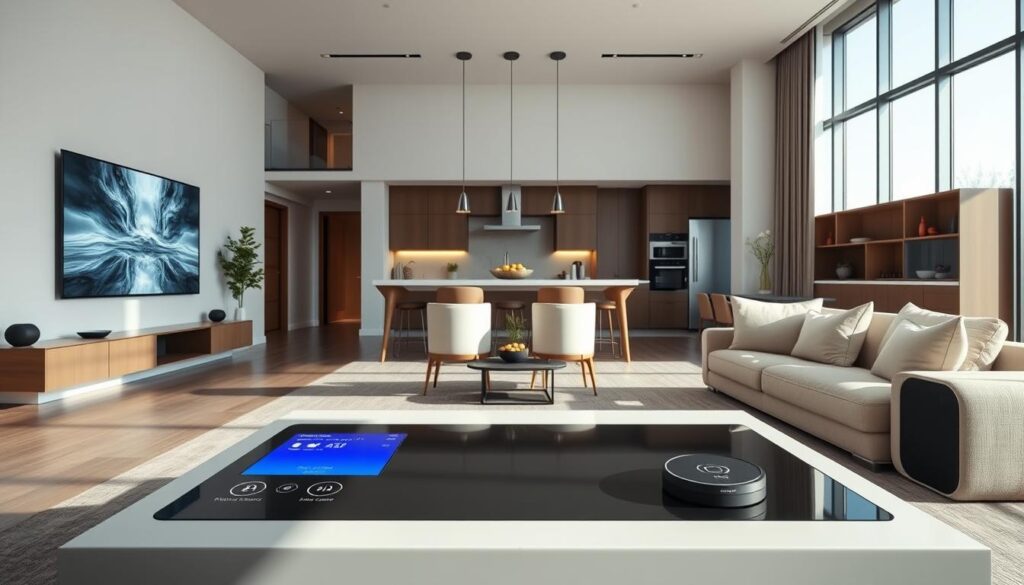
Minimalist Design
Minimalist design is all about simplicity and function. In smart homes, it blends tech with decor smoothly. This keeps the look clean and simple.
Key Features: It has clean lines, little decor, and focuses on function. Smart devices are hidden, keeping the minimalist look.
Modern and Contemporary Aesthetics
Modern and contemporary designs use the latest tech and materials. They feature open spaces, big windows, and focus on being green. Smart lights and temperature control make living better.
Characteristics: They have open layouts, advanced materials, and aim for energy savings. Tech is a design feature here.
Eclectic Styles
Eclectic designs mix different styles and periods for a unique space. Tech makes these spaces more functional and comfy. For example, smart speakers fit in with old decor, and smart lights highlight art.
Benefits: They are very personal, flexible, and can have many decorative items. Tech meets the space’s varied needs.
As we keep using tech in home design, these styles will grow. They’ll offer new ways to live and enjoy our homes. Whether you like simple, sleek, or eclectic, tech can make your home better.
Choosing the Right Smart Devices for Your Home
Smart home devices can make your living space more convenient and stylish. As we add more technology to our homes, picking the right devices is key. They should meet our needs and match our home’s look.
Factors to Consider
When picking smart devices, think about a few things. First, check if they work well with your current smart home setup. It’s important for a smooth experience.
Also, look for devices that are easy to use. They shouldn’t need a lot of tech knowledge. Plus, make sure your smart home can grow with you, letting you add or remove devices easily.
Popular Brands and Their Offerings
Many brands are leading the smart home market with their cool products and big ecosystems.
| Brand | Notable Products | Ecosystem Features |
|---|---|---|
| Amazon | Echo, Ring | Alexa integration, wide compatibility |
| Nest Thermostat, Google Home | Google Assistant, seamless integration with other Google services | |
| Apple | HomePod, Apple Watch | Siri integration, secure ecosystem |
By thinking about these points and checking out what popular brands offer, you can make a smart home that’s both useful and looks great. The future of home design is here, and it’s smarter than ever.
Challenges in Smart Home Interior Design
As we move towards a more connected home design, several hurdles need to be overcome. Smart home interior design, while offering numerous benefits, also presents unique challenges that homeowners and designers must navigate.
Integrating Technology Seamlessly
One of the primary challenges in smart home interior design is integrating technology seamlessly into the living space. This involves ensuring that smart devices not only function effectively but also blend in with the aesthetic of the home.
Key Considerations for Seamless Integration:
- Designing a system that is intuitive and user-friendly
- Ensuring that devices are compatible with each other
- Minimizing visible wiring and infrastructure
- Selecting devices that complement the home’s décor
According to a report by Forbes, “the key to a successful smart home is integration.” This highlights the importance of a cohesive approach to smart home design.
“The future of smart homes is not just about having the latest gadgets, but about creating a living space that is responsive to our needs.”
Cost Considerations
Another significant challenge is the cost associated with smart home gadgets for interiors. While the cost of smart devices is decreasing over time, setting up a fully integrated smart home system can still be expensive.
| Device Type | Average Cost | Installation Cost |
|---|---|---|
| Smart Thermostats | $200-$300 | $100-$200 |
| Smart Lighting | $100-$500 | $50-$200 |
| Smart Security Systems | $500-$1000 | $200-$500 |
It’s essential for homeowners to weigh the costs against the benefits and consider factors like energy efficiency and enhanced security when making decisions about smart home devices.
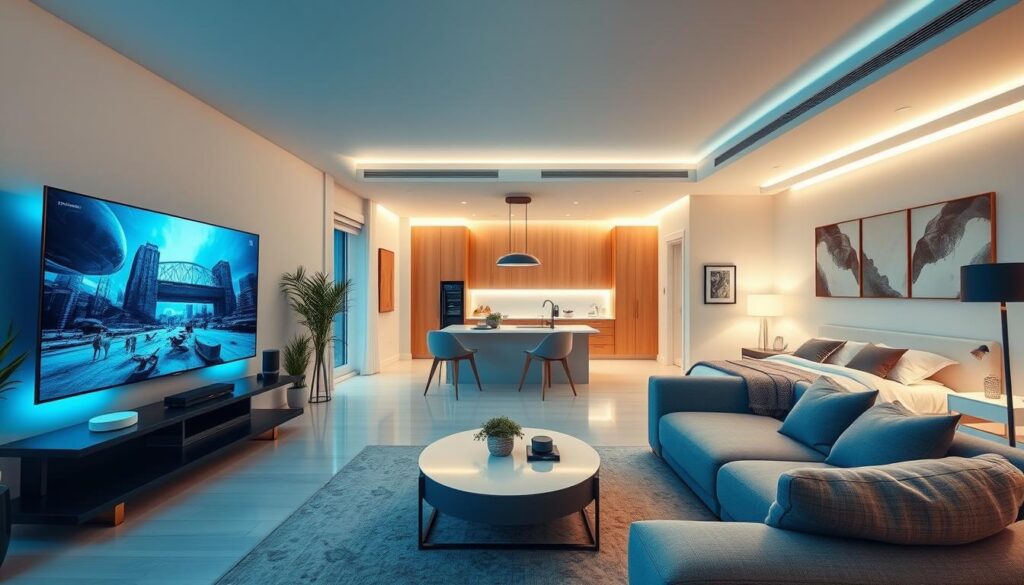
By understanding these challenges and carefully planning the integration of smart home technology, homeowners can create a living space that is both technologically advanced and aesthetically pleasing.
Maintaining Your Smart Home Interior
Keeping your smart home interior in top shape is key. It lets you enjoy the latest smart tech and design trends. Regular upkeep ensures your smart devices and design stay up to date.
Regular maintenance includes a few important steps. First, update software and devices to keep them secure and working well.
Updating Software and Devices
It’s crucial to keep your smart devices and software current. This ensures they work well and stay safe. Check for updates on your smart speakers, lights, thermostats, and more.
Manufacturers often release updates to fix issues and add new features. To update, open the device’s app, check for updates, and follow the prompts.
Enabling automatic updates is a smart move. It keeps your devices current without you having to do anything.
Troubleshooting Common Issues
Even with the best care, problems can still happen. Knowing how to fix common issues saves time and stress. Issues like connectivity problems, device malfunctions, and software bugs are common.
For connectivity issues, try restarting your router and devices. Check for physical barriers or interference. Make sure devices are close to the network.
For malfunctions or software bugs, try resetting the device or reinstalling the app. If problems continue, reach out to the manufacturer’s support.
By keeping up with maintenance and knowing how to fix issues, your smart home stays comfortable, convenient, and efficient.
Future Trends in Smart Home Interior Design
Smart home interior design is on the verge of a big change. AI and automation are leading the way. Our homes are getting smarter, blending well with our daily lives.
Advancements in AI and Automation
AI is playing a bigger role in smart home design. It lets homes learn and adjust to our likes. Automation makes it simple to control things like lights and temperature.
- Personalized Experiences: AI systems now offer tailored experiences. They adjust settings based on time, who’s home, and the weather.
- Voice Control: Voice assistants are becoming common. They let us control smart devices without using our hands.
- Predictive Maintenance: AI can spot problems before they get big. This keeps our homes safe and running smoothly.
Emerging Design Trends
As tech improves, so do smart home design trends. Some new trends include:
- Sustainable Design: Smart homes are now using eco-friendly materials and saving energy.
- Minimalist Aesthetics: Tech integration is making designs simpler. Devices are becoming less noticeable.
- Wellness-Focused Design: Homes are being designed to improve our health. This includes air quality checks and lights that match our natural rhythms.
The future of smart home design looks bright. It will be shaped by new tech and a focus on making homes better for living.
Getting Started with Smart Home Interior Design
Starting a smart home interior design journey needs careful thought. We’ll look into modern home automation and futuristic design. It’s key to know what we need and want.
Assessing Needs
First, figure out which parts of your home could use smart tech. Think about your daily life. How can smart devices make your home more comfortable, convenient, and energy-saving?
Collaboration with Experts
Design pros can guide you through the many smart home options. They help create a unified, futuristic look. They share the newest trends and tech in smart homes.
DIY Projects
If you like doing things yourself, DIY smart home projects are great. Start with easy tasks like smart lights or thermostats. This builds your skills and confidence with smart tech.
By starting with these steps, you can fully enjoy smart home design. You’ll make a space that’s smart and inspiring.

